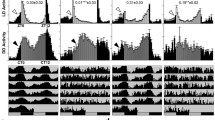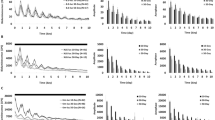Abstract
The period (per) gene of Drosophila melanogaster is involved in the expression of circadian rhythms of locomotor activity in adult flies1. Molecular studies of per (reviewed in ref. 2) have shown that the transcribed and translated products of this gene are present primarily at the embryonic, pupal and adult stages3–8. Here we describe experiments with arrhythmic per mutants bearing an inducible form of this gene which indicate that strongly rhythmic adult behaviour can be obtained only if per expression is induced in the adult, independent of its history of expression earlier in development. Thus per-mutant locomotor-activity phenotypes seem not to result from abnormalities in the development of neural structures or in physiological processes that may be required at pre-adult stages for the expression of this circadian rhythm. Moreover, the action of per after light:dark cycle entrainment seems to be sufficient for activity rhythms to be exhibited in constant darkness; this suggests further that the per product is required only during the time that the rhythmic behaviour is being manifested. Our strategy used a heat-shock gene promotor fused to per coding sequences to obtain conditional gene expression. Heat-shock promoter-driven genes have previously been used to study the mode of action and tissue specificity of a variety of Drosophila genes9–16; our experiments on circadian rhythms demonstrate the use of such gene constructions for the temporal manipulation of genes whose phenotypes, behavioural and otherwise, affect whole organisms.
Similar content being viewed by others

References
Konopka, R. J. & Benzer, S. Proc. natn. Acad. Sci. U.S.A. 68, 2112–2116 (1971).
Hall, J. C. & Rosbash, M. J. Biol. Rhythms 2, 153–178 (1987).
Reddy, P. et al. Cell 38, 701–710 (1984).
Bargiello, T. A. & Young, M. W. Proc. natn. Acad. Sci. U.S.A. 81, 2142–2146 (1984).
James, A. J., Ewer, J., Reddy, P., Hall, J. C. & Rosbash, M. EMBO J. 5, 2313–2320 (1986).
Bargiello, T. A. et al. Nature 328, 686–691 (1987).
Siwicki, K. K., Eastman, C., Petersen, G., Rosbash, M. & Hall, J. C. Neuron (in the press).
Liu, X., Lorenz, L., Yu, Q., Hall, J. C. & Rosbash, M. Genes Dev. 2, 228–238 (1988).
Lis, J. T., Simon, J. A. & Sutton, C. A. Cell 35, 403–410 (1983).
Dudler, R. & Travers, A. A. Cell 38, 391–398 (1984).
Bonner, J. J., Parks, C., Parker-Thornburg, J., Mortin, M. A. & Pelham, H. R. B. Cell 37, 979–991 (1984).
Steller, H. & Pirrotta, V. EMBO J. 4, 3765–3772 (1985).
Struhl, G. Nature 318, 677–680 (1985).
Steller, H. & Pirrotta, V. Molec cell. Biol. 6, 1640–1649 (1986).
Schneuwly, S., Klemenz, R. & Gehring, W. J. Nature 325, 816–818 (1987).
Boggs, R. T., Gregor, P., Idriss, S., Belote, J. M. & McKeown, M. Cell 50, 739–747 (1987).
Rubin, G. M. Trends Neurosci. 8, 231–233 (1985).
Hamblen, M. et al. J. Neurogenet. 3, 249–291 (1986).
Klemenz, R., Hultmark, D. & Gehring, W. J. EMBO J. 4, 2053–2060 (1985).
Smith, R. F. & Konopka, R. J. Molec. gen. Genet. 185, 30–36 (1982).
Cote, G. & Brody, S. J. J. theoret. Biol. 121, 487–503 (1986).
Baylies, M. K., Bargiello, T. A., Jackson, F. R. & Young, M. W. Nature 326, 390–392 (1987).
Zehring, W. A. et al. Cell 39, 369–376 (1984).
Livingstone, M. S. Neurosci. Abstr. 7, 351 (1981).
Weitzel, G. & Rensing, L. J. Comp. Physiol. 143, 229–235 (1981).
Smith, R. F. & Konopka, R. J. Molec. gen. Genet. 183, 243–251 (1981).
Konopka, R. J. & Wells, S. J. Neurobiol. 11, 411–415 (1980).
Jackson, R. F., Bargiello, T. A., Yun, S-H. & Young, M. W. Nature 320, 185–188 (1986).
Citri, Y. et al. Nature 326, 42–47 (1987).
Rubin, G. M. & Spradling, A. C. Nucleic Acids Res. 11, 6341–6351 (1983).
Ashburner, M. & Bonner, J. J. Cell 17, 241–254 (1979).
Author information
Authors and Affiliations
Rights and permissions
About this article
Cite this article
Ewer, J., Rosbash, M. & Hall, J. An inducible promoter fused to the period gene in Drosophila conditionally rescues adult per-mutant arrhythmicity. Nature 333, 82–84 (1988). https://doi.org/10.1038/333082a0
Received:
Accepted:
Issue Date:
DOI: https://doi.org/10.1038/333082a0
- Springer Nature Limited
This article is cited by
-
A lack of locomotor activity rhythms inDrosophila melanogaster larvae (Diptera: Drosophilidae)
Journal of Insect Behavior (1994)
-
Clock mutations alter developmental timing in Drosophila
Heredity (1990)
-
The molecular ethology of theperiod gene inDrosophila
Behavior Genetics (1990)
-
Designing heat-shock clocks
Nature (1988)




